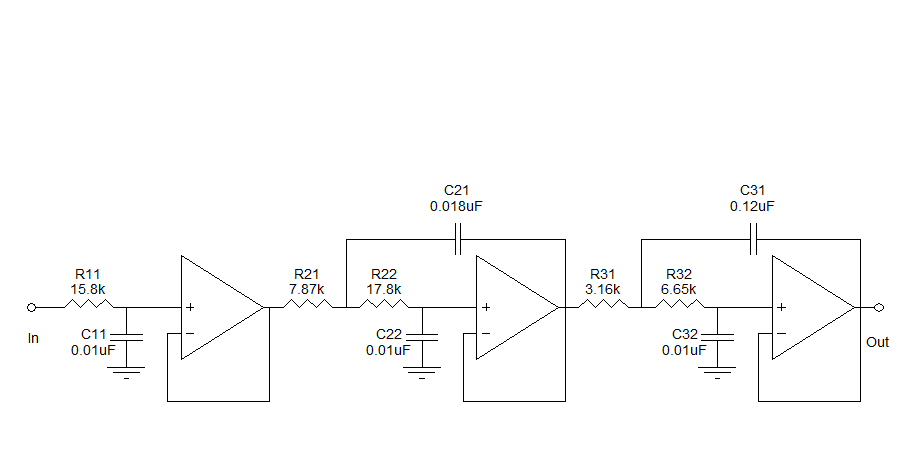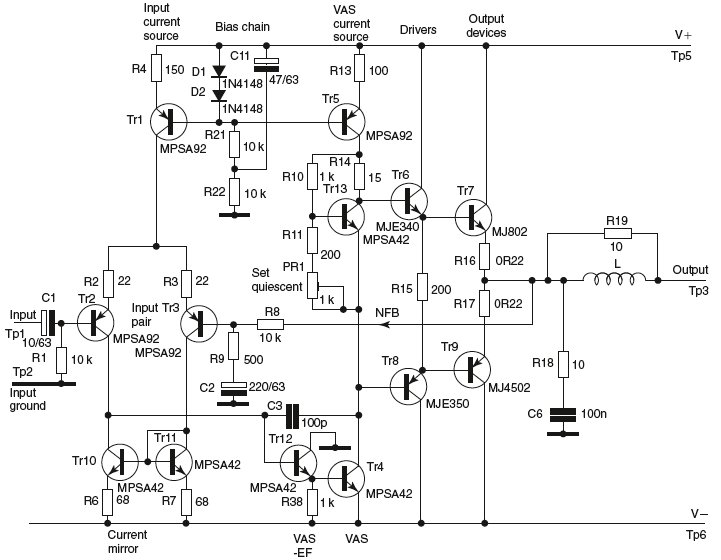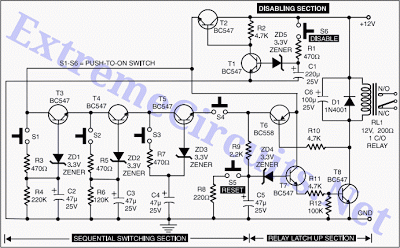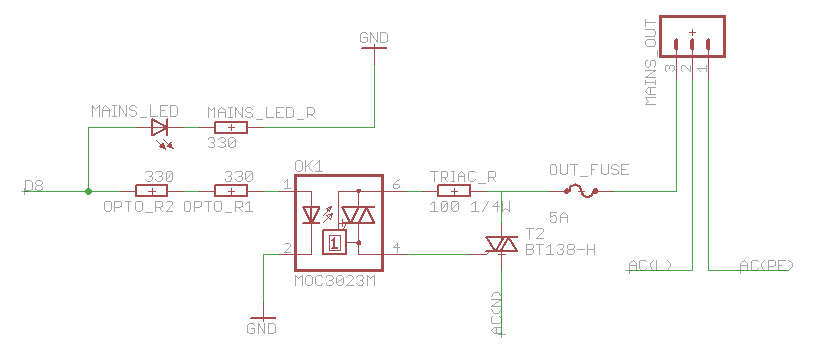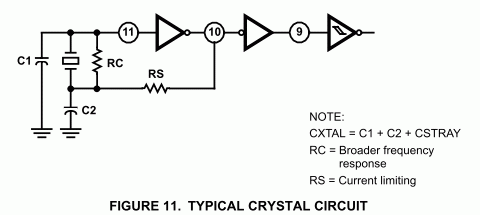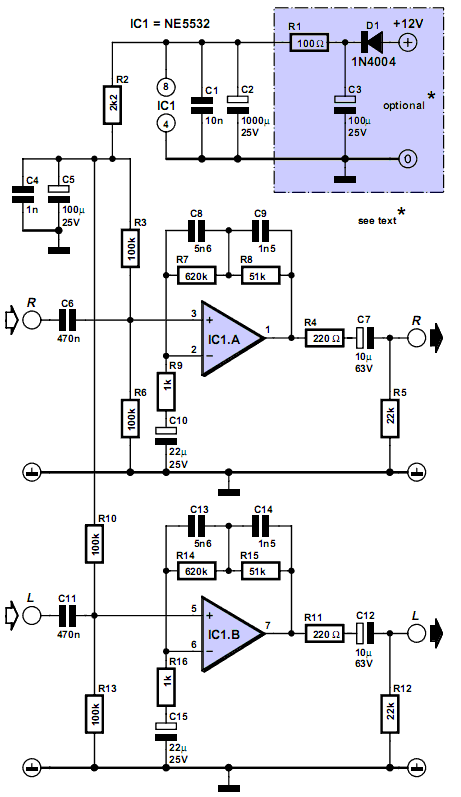
amplifier circuit

This audio amplifier circuit utilizes the TDA7294, a power integrated circuit designed for high-quality audio applications. The TDA7294 operates as a class AB amplifier, characterized by low noise and distortion levels, a wide bandwidth, and robust output current capability. It is capable of delivering over 50W RMS into 4 or 8-ohm loads with a total harmonic distortion (THD) and intermodulation distortion (IMD) of less than 0.1%. The circuit includes short circuit and thermal protection features, enhancing its reliability. With a few additional components and an appropriate power supply, this amplifier is suitable for both hi-fi applications and as an upgrade or replacement for existing amplifiers in the 30W-50W range, assuming they are equipped with a compatible dual power supply. A similar configuration was previously published in Elektor magazine in November 1996.
The TDA7294 audio amplifier circuit is designed to provide high-quality sound reproduction in a variety of audio applications. The circuit configuration typically includes the TDA7294 IC, which serves as the primary amplification component. To optimize performance, the circuit should incorporate the necessary passive components such as resistors, capacitors, and inductors that support the desired frequency response and stability of the amplifier.
The power supply for this amplifier should be dual, providing both positive and negative voltages to the TDA7294. This is crucial for the class AB operation, allowing the amplifier to handle both the positive and negative halves of the audio signal effectively. The recommended voltage range for the power supply is typically between ±12V and ±25V, depending on the desired output power and load impedance.
To enhance the performance further, the circuit may include additional features such as a volume control potentiometer, input coupling capacitors to block DC offsets, and output coupling capacitors to prevent DC from reaching the speakers. Implementing proper heat sinking is also essential to dissipate heat generated during operation, ensuring the longevity and reliability of the amplifier.
The inclusion of short circuit and thermal protection circuits is vital for safeguarding the TDA7294 against potential damage due to overload conditions. The thermal protection feature automatically reduces the amplifier output when the chip exceeds its safe operating temperature, while the short circuit protection disables the output when a short circuit is detected.
In summary, the TDA7294 audio amplifier circuit is a versatile and robust solution for high-fidelity audio amplification, capable of delivering excellent sound quality with minimal distortion. Its design allows for easy integration into existing audio systems, making it an attractive option for both DIY enthusiasts and professional audio applications.This is a great audio amplifier circuit based on single power IC TDA7294. TDA7294 is intended for use as a high quality audio class AB amplifier in hi-fi applications. It has very low noise and distortion, wide bandwidth and good output current capability, enabling it to supply high power into both 4 © and 8 © loads. It has both short circuit and thermal protection, so is quite robust. With the addition of a handful of parts and a suitable power supply, this module will deliver over 50W RMS into 4 or 8 ohms with < 0.
1% Total Harmonic Distortion (THD) and < 0. 1% Intermodulation Distortion (IMD). A similar circuit was published in Elektor magazine, 11/96. It is also suitable as a replacement power amp stage, or upgrade for many existing amplifiers of between 30W-50W, provided they have a suitable dual supply, and most do. 🔗 External reference
The TDA7294 audio amplifier circuit is designed to provide high-quality sound reproduction in a variety of audio applications. The circuit configuration typically includes the TDA7294 IC, which serves as the primary amplification component. To optimize performance, the circuit should incorporate the necessary passive components such as resistors, capacitors, and inductors that support the desired frequency response and stability of the amplifier.
The power supply for this amplifier should be dual, providing both positive and negative voltages to the TDA7294. This is crucial for the class AB operation, allowing the amplifier to handle both the positive and negative halves of the audio signal effectively. The recommended voltage range for the power supply is typically between ±12V and ±25V, depending on the desired output power and load impedance.
To enhance the performance further, the circuit may include additional features such as a volume control potentiometer, input coupling capacitors to block DC offsets, and output coupling capacitors to prevent DC from reaching the speakers. Implementing proper heat sinking is also essential to dissipate heat generated during operation, ensuring the longevity and reliability of the amplifier.
The inclusion of short circuit and thermal protection circuits is vital for safeguarding the TDA7294 against potential damage due to overload conditions. The thermal protection feature automatically reduces the amplifier output when the chip exceeds its safe operating temperature, while the short circuit protection disables the output when a short circuit is detected.
In summary, the TDA7294 audio amplifier circuit is a versatile and robust solution for high-fidelity audio amplification, capable of delivering excellent sound quality with minimal distortion. Its design allows for easy integration into existing audio systems, making it an attractive option for both DIY enthusiasts and professional audio applications.This is a great audio amplifier circuit based on single power IC TDA7294. TDA7294 is intended for use as a high quality audio class AB amplifier in hi-fi applications. It has very low noise and distortion, wide bandwidth and good output current capability, enabling it to supply high power into both 4 © and 8 © loads. It has both short circuit and thermal protection, so is quite robust. With the addition of a handful of parts and a suitable power supply, this module will deliver over 50W RMS into 4 or 8 ohms with < 0.
1% Total Harmonic Distortion (THD) and < 0. 1% Intermodulation Distortion (IMD). A similar circuit was published in Elektor magazine, 11/96. It is also suitable as a replacement power amp stage, or upgrade for many existing amplifiers of between 30W-50W, provided they have a suitable dual supply, and most do. 🔗 External reference
